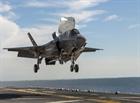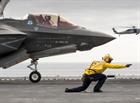F-35B update November
Flight testing
The 33rd Fighter Wing and the F-35 Lightning II program reached a new milestone when Marine Fighter Attack Training Squadron-501 completed its first short take-off and vertical landing mission 24 October at Eglin airforce base.
Maj. Brendan M. Walsh flew the hour-long mission in which the aircraft remained in the STOVL configuration for the entire flight. The aircraft flew pattern procedures around the base before gliding in, stopping in mid-air about 100 feet off the Eglin runway, performing a stationary right turn and slowly lowered to the ground.
"This mission made one of the key capabilities for this fighter an operational reality not just for VMFAT-501, but for the entire F-35B program," said Lt. Col. David Berke, the VMFAT-501 commander. "Our expeditionary operations are rapidly evolving, and STOVL capabilities give us a flexibility to stage our aircraft not just from major bases and carriers, but also out of damaged airstrips and other austere operating sites."
Walsh is the only pilot at Eglin qualified to fly in the STOVL configuration, but he said the flight paved the way to locally train F-35B instructors and new students in STOVL operations.
The STOVL operation also marks a significant achievement in the program for some partner countries. VMFAT-501 hosts three pilots and 13 maintainers from the United Kingdom's Royal Air Force and Royal Navy.
Weapons testing
An F-35B short take-off and vertical landing (STOVL) fighter aircraft piloted by Marine Corps Maj. Richard Rusnok, successfully employed a Guided Bomb Unit-12 (GBU-12) Paveway II laser-guided weapon from the F-35's internal weapons bay against a fixed ground tank test target 29 October 2013.
The F-35B released its weapon from 25,000 feet and the bomb fell for 35 seconds before hitting a stationary target (a tank) on the Edwards Air Force Base Precision Impact Range Area.
The F-35 used its Electro-Optical Targeting System (EOTS) to enable the pilot to identify, track, designate and accurately deliver the GBU-12 on target. EOTS is the world's first sensor to combine forward-looking infrared, infrared search and track, and laser designator to maximize capability for F-35 pilots.
You tube video of the weapon drop.





